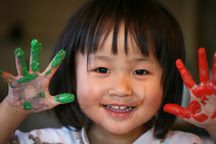 Stress-Busting Gets Creative
Stress-Busting Gets CreativeArt education can help children cope with worries. Children under stress tend to bottle up their feelings, creating emotional and physical effects. With negative news dominating our newspapers and airwaves – from a struggling economy and war to issues closer to home with worried parents, less disposable income and school stress -- children need to find healthy ways to manage. Art is one of the best ways you can help your children develop skills to express themselves and liberate their feelings to help maintain healthy emotional well-being.
The key in reducing or eliminating unhealthful stress is to provide children with the tools and attention to deal with stress and by giving them a healthy outlet that sets them up with coping skills for life.
Artful calming
Art for kids should be all about originality and creativity. You can create a space at home that promotes imaginative play:
* Set up a creativity center that your children can access, which contains lots of paper, crayons, markers, nontoxic paints and brushes, modeling compounds (like Crayola Model Magic®) and more;
* You can spiff up your creativity center by encouraging your children to add recycled materials from around the house (paper towel and toilet paper tubes; bows, ribbon, bottle caps, postcards, printer paper and more;
* Identify a place where your children can create art, such as your kitchen or a coffee table. Set up the rules, such as working on plastic or newspaper;
Instead of plopping down in front of the TV or a video game, encourage your children to grab their creativity tools and make something new;
* Create meaningful patterns, such as sitting with your children before they start their art, and teach them a relaxation technique. Tell them to shut their eyes, take a deep breath while they count to five and then slowly exhale while counting to five. Play with the idea, such as “in through the nose and out through the mouth” and “in through the mouth and out through the nose;”
* Never ever judge your children’s artwork. You want to empower them to use art to express their ideas, thoughts and feelings.
Above all, children need to know that they are loved and supported. Give hugs and model grace, calm and problem-solving. Sometimes children need just 15 minutes of your undivided attention. They need to turn off the TV and sources of distraction and learn to turn within to tap their own imaginations where a world of creative adventure awaits. 
Art classes are another wonderful way to promote stress-busting, while fostering imaginative learning and developing new visual arts skills, technique and vocabulary. Learn more about Abrakadoodle remarkable art classes, in-school field trips, workshops, camps and parties: http://www.abrakadoodle.com/programs.htm.





